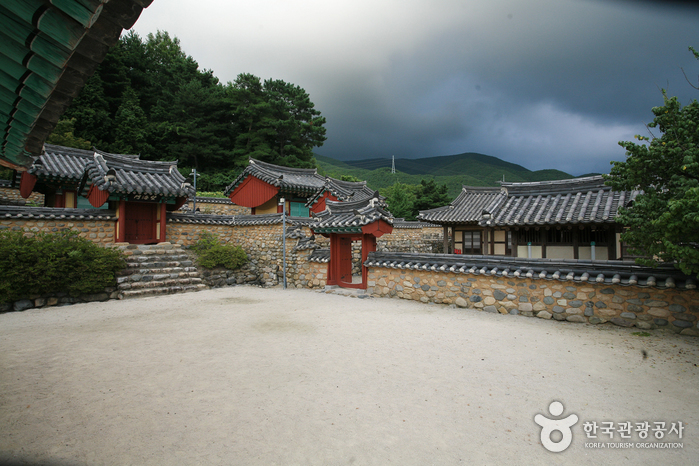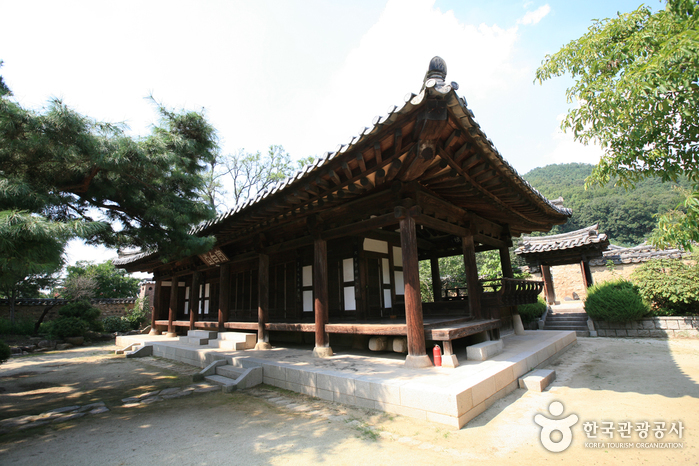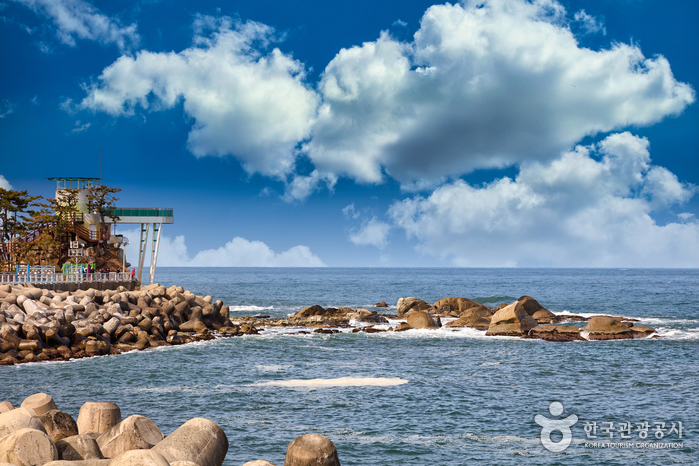Korean Traditional House Association (한국전통가옥협회)
2016-12-01
16-5, Goyangsicheong-ro, Deogyang-gu, Goyang-si, Gyeonggi-do
+82-31-907-2007
Korea Traditional House Association studies traditional houses which embrace the spirit of the ancestors and develop traditional cultural asset by creating miniatures of the houses. Through in-site survey and history of ancestors, the area is reproduced intact down to the structure, materials and architectural method used, creating a lively miniature village.
Chisanseowon Confucian Academy (치산서원)
2020-02-05
7, Chisullyeong-gil, Dudong-myeon, Ulju-gun, Ulsan
+82-52-204-0324
Relics of Park Jesang is also referred to as Chisanseowon Confucian Academy.
Park Jesang, a descendent of Park Hyeokgeose, was severly tortured and then burned to death after rescuing two hostages taken by Japan, who were the brothers of King Nulji.
The nearby temple and Mangbuseok have a folk tale regarding the story. His wife and two daughters died waiting for him and then his wife is said to have turned into Mangbuseok (faithful wife stone) in the eastern Chisullyeong Mountain in Manhwa-ri, Dudong-myeon. According to the legend, her spirit became a bird, and flew away to hide behind Euneulam (Bird Hidden Rock).
After Park Jesang's couragous act, King Nulji gave him a loyal officers position as well as the role of godmother to his wife for her model behavior of wifely duty. Chisanseowon Confucian Academy keeps their ancestral tablets to honor royalty.
Petroglyphs of Cheonjeon-ri [UNESCO World Heritage] (울주 천전리 명문과 암각화 [유네스코 세계유산])
2025-07-18
Cheonjeon-ri, Dudong-myeon, Ulju-gun, Ulsan
The petroglyphs (figures, pictures, and letters were made on the rocks along the mid-stream area of Naegokcheon Stream, which is a tributary of Taehwagang River. The upper and lower sides of the rocks contain petroglyphs that differ in the content and techniques used. The upper side contains petroglyphs made by means of chiseling. The inscriptions include geometric patterns, animals, and abstract human figures. There are concentric circles, with a round figure looking like the sun at the center, four running deer next to them, and several semi-human animals. The figures with simplistic expression and symbolism appear to have been made during the Bronze Age.
The lower side contains line-drawn picture mixed with Chinese characters. They include a procession of horse riders, animals including dragons, and boats. In particular, the procession of horse riders appears in three different places. The boats provide researchers with important information on the offshore activities carried out by people of the Silla dynasty. The 800-plus written characters are about the King and Queen’s visit to the place. They were presumed to have been inscribed on two occasions during the reign of King Beopheung (r. 514-540) of the Silla dynasty. The content on the official positions and the government system makes it a precious material for those studying Silla during or around the 6th Century. The petroglyphs were made by many people over an extended period of time, providing vivid information on the life and thoughts of people from prehistoric times to the Silla dynasty.
The petroglyphs in Cheonjeon-ri and petroglyphs on the Bangudae Terrace, spanning three kilometers altogether along the Bangucheon Stream, have been inscribed on the UNESCO World Heritage List on July 12, 2025.
(Source: Korea Heritage Service)
Village of the Nampyeong Mun Clan in Bon-ri (남평문씨본리세거지)
2021-03-16
16, Inheung 3-gil, Dalseong-gun, Daegu
+82-53-668-3162
The Village of the Nampyeong Mun Clan in Bon-ri was built on what used to be part of a temple, but was organized following a well-field system to make the area a residence for many generations. As of now, nine houses and two pavilions remain, as well as a low wall along the road.
The main building of the village is Subongjeongsa, located in the center of the area. It was used for meeting guests, as well as a gathering place for the family, and features beautiful gardens. Gwanggeodang Hall was an educational place for studies and refinement. Insumungo Storage Building preserves about 10,000 books and clan treasures. It started out as a small building but later was expanded, including an additional building constructed just to read books.
Namae Beach (Namae 1, 3-ri) (남애해변(남애1, 3리))
2021-07-16
Gwangjin-ri, Yangyang-gun, Gangwon-do
+82-33-670-2518
In addition to the beautiful Maeho Lagoon at its side, Namae-ri is home to three beaches. The northernmost Namae Beach is the largest among the three, with a sandy shore that is 2 kilometers long and 100 meters wide. The beach has great quality sand and shallow waters, with an average depth of only 1 to 2 meters. Also, a field of reeds is beautifully stretched out on both sides of the stream flowing from Maeho Lagoon. Near Maeho Lagoon is the breeding ground for egrets and grey herons in Pomae-ri, designated as Natural Monument No. 229.
The other two beaches in Namae-ri consist of Namae 1(il)-ri Beach, a charming small beach in the furthest south, and Namae 3(sam)-ri Beach, located near Naemae Port.
Namaehang Port (남애항)
2025-01-14
138 , Maebawi-gil, Yangyang-gun, Gangwon-do
+82-33-670-2398
The largest port in Yangyang area is also one of the Eight Sights of Yangyang, and along with Simgokhang Port of Gangneung and Chogokhang Port of Samcheok, said to be the three most beautiful ports in Gangwon-do. Indeed, its reputation can be seen in the picturesque view of the white and red lighthouse, breakwater, and the fishing boats docked at the port. Another point of interest at Namaehang Port is the Namaehang Skywalk Observatory. Located at the entrance to the breakwater, this observation point offers a breathtaking view of the Namaehang Port area and the East Sea. The island, where the skywalk is located, was called Yangyado Island during the Joseon period, and the site of this observation point used to have a beacon during the Joseon period. Namae Fishing Village Experience, a village that is fed by the Namaehang Port, offers fishing boat trips for visitors, along with hand fishing, rock crab catching, and stuffed squid making. Some of Namaehang Port’s major catches include squid, plaice, and flatfish. A line of restaurants specializing in raw fish slices allows visitors to enjoy the fresh catch right away.
Yeongdodaegyo Bridge (영도대교)
2023-04-22
46, Taejong-ro, Yeongdo-gu, Busan
+82-1670-8114
Yeongdodaegyo Bridge, connecting Nampo-dong and Yeongdo Island, was the first bridge to connect the mainland to one of the nearby islands in Busan. The bridge lifted to allow ships to pass between the south and north ports, and made a passage for ships anywhere from two to seven times in one day. When the bridge was first constructed, many people would gather to watch the strange spectacle of a bridge rising up to point to the sky. The bridge remains a famous landmark of Busan even to this day.
Twelve Tablet Pavilion of Hyeonpung Gwak Clan (현풍곽씨십이정려각)
2020-04-14
3, Jidong-gil, Dalseong-gun, Daegu
+82-53-668-3162
Designated as Daegu’s Cultural Property No. 29 on May 12, 1995, Twelve Tablet Pavilion of Hyeonpung Gwak Clan (Jongnyeo-gak of the Hyeonpung Lineage of the Kwak Clan) was built in the mid-Joseon period during King Yeongjo's rule. The pavilion houses 12 Jeongnyeo-gak tablets awarded to the members of the Gwak Clan from the time of King Seonjo in 1598 to the time of King Yeongjo.
It is an important and unique hertiage because the Gwak Clan attained their 12 Jeongnyeo-gak tablats all in one village, which is quite uncommon. During the Joseon dynasty, Jeongnyeo-gak tablets were awarded to honor loyal retainers, devoted sons, and exemplary husbands and wives.
Gooam Farmstay Village (구암팜스테이마을)
2024-03-15
8-1 Guam-gil, Dong-gu, Daegu
+82-53-984-5273
Known as "Gooam" due to its rock formations resembling turtle's shell, Gooam Farmstay Village offers various activities such as harvesting agricultural produce, traditional food making, traditional games, and craft experiences. Depending on the season, there are experiences like picking strawberries, digging potatoes, picking cherry tomatoes, gathering chestnuts, and harvesting persimmons. Visitors can also participate in making bean curd, rice cakes, kimchi, catching loaches, making kite, and experiencing hanji crafts.
Gangwon Hyuhyuam Hermitage (휴휴암(강원))
2025-01-13
3-16, Gwangjin 2-gil, Yangyang-gun, Gangwon-do
+82-33-671-0526
This hermitage is located by the sea at Hyeonnam-myeon, Yangyang-gun, Gangwon-do. Its name reflects its dedication to the value of rest by freedom from the troubles of mundane life. The temple was built in 1997 by the monk Hongbeop as a small Buddha hall named Myojeokjeon Hall, but the discovery of a large rock shaped like a reclining Avalokiteshvara in 1999 made the temple a popular site for prayers. A large rock named Yeonhwadae, named after its shape of a lotus flower in bloom, is located below the Myojeokjeon Hall near the sea. Yeonhwadae is a great place to see the reclining Avalokiteshvara and turtle-shaped rock in the area, and many other tourists flock to see the interesting rock formations of the area, like toe rocks, foot rock, and fist rock. Lucky visitors can catch a glimpse of schools of big-scaled redfin surfacing to feed at the beach. Hyuhyuam Hermitage is also home to Myojeokjeon Hall, Darani Cave Buddha Hall, Gwaneum Buddhist Bell, and a statue of the Avalokiteshvara. The Avalokiteshvara statue, in particular, enjoys great popularity from its hilltop vantage point, having the blue seas of the East Sea to its back.


![Petroglyphs of Cheonjeon-ri [UNESCO World Heritage] (울주 천전리 명문과 암각화 [유네스코 세계유산])](http://tong.visitkorea.or.kr/cms/resource/14/3335114_image2_1.jpg)




 English
English
 한국어
한국어 日本語
日本語 中文(简体)
中文(简体) Deutsch
Deutsch Français
Français Español
Español Русский
Русский